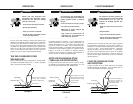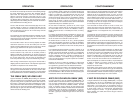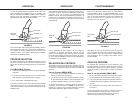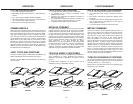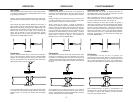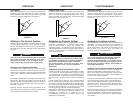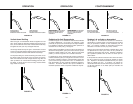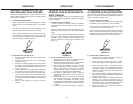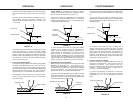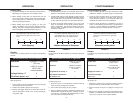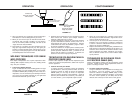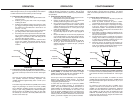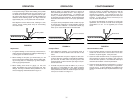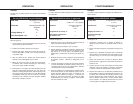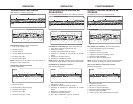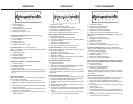
31
3. The Correct Contact Tip to Work Distance(CTWD)
The Contact Tip to Work (CTWD) is the distance from the
end of the contact tip to the end of the wire. (See Figure
15.)
Once the arc has been established, maintaining the cor-
rect (CTWD) becomes extremely important. The
(CTWD) should be approximately 3/8 to 1/2 inch (10 to
12 mm) long.
FIGURE 15
The easiest way to tell whether the (CTWD) is the correct
length is by listening to its sound. The correct (CTWD)
has a distinctive “crackling” sound, very much like eggs
frying in a pan. A long (CTWD) has a hollow, blowing or
hissing sound. If the (CTWD) is too short, you may stick
the contact tip or nozzle to the weld puddle and/or fuse
the wire to the contact tip.
4. The Correct Welding Speed
The important thing to watch while welding is the puddle
of molten metal right behind the arc. See Figure 16. Do
not watch the arc itself. It is the appearance of the pud-
dle and the ridge where the molten puddle solidifies that
indicates correct welding speed. The ridge should be
approximately 3/8” (10 mm) behind the wire electrode.
Most beginners tend to weld too fast, resulting in a thin
uneven, “wormy” looking bead. They are not watching
the molten metal.
FIGURE 16
OPERATION
3. La extremidad correcta del contacto para trabajar dis-
tancia (CTWD) La extremidad del contacto a trabajar
(CTWD) es la distancia del final de la extremidad del con-
tacto al extremo del alambre.(Vea la Figura 15).
Una vez que el arco se ha establecido, es muy importante
mantener una distancia
(CTWD)
correcta. La punta de
alambre
(CTWD)
debe ser de 10 a 12 mm de largo (3/8 a
1/2 pulgadas) aproximadamente.
FIGURA 15
La forma más fácil para saber si la punta de alambre
(CTWD)
tiene la longitud correcta, es escuchando su
sonido. Una punta de alambre
(CTWD)
correcta tiene un
sonido distintivo de “chisporroteo”, muy similar al que se
produce cuando se fríen alimentos en una sartén. Una
punta de alambre
(CTWD)
larga tiene un sonido hueco o
como de silbido. Si la
(CTWD)
es muy corta, usted podría
colocar la punta de contacto o la tobera en el charco de sol-
dadura, y/o fusionar el alambre con la punta de contacto.
4. Velocidad Correcta de Soldadura
Mientras suelda, es importante observar el charco de metal
derretido justo detrás del arco. Vea la Figura 16. No
observe el arco directamente. La apariencia del charco y
el reborde donde se solidifica es lo que indica la velocidad
correcta de soldadura. El reborde detrás del electrodo
tubular debe ser de 10 mm (3/8”) aproximadamente.
La mayoría de los principiantes tiende a soldar muy rápido,
dando como resultado un cordón delgado, disparejo y con
apariencia “ondulada”. Cuando esto sucede, significa que
no están observando el metal derretido.
FIGURA 16
OPERACIÓN FONCTIONNEMENT
Solidifying ridge
Molten puddle
Solidificación del reborde
Charco de
soldadura
3/8 – 1/2” (10 – 12 mm)
(CTWD)
Contact Tip
Wire Electrode
La punta electrizada de alambre
(CTWD) 10-12 mm (3/89-1/2 pulg.)
Punta de
Contacto
Electrodo
de alambre
3. Le bout correct de contact pour travailler la distance
Le bout de contact à travailler (CTWD) est la distance de
la fin du bout de contact à l'extrémité du fil. (Voir la figure
15)
Une fois que l'arc a été établi, le maintien du correct
(CTWD) devient extrêmement important. (CTWD) devrait
être approximativement pouce de 3/8 à de 1/2 (10 à 12
millimètres) long.
FIGURE 15
La manière la plus facile de dire si (CTWD) est la
longueur correcte est en écoutant son bruit. Le correct
(CTWD) a un bruit distinctif de "crépitement", infiniment
comme des oeufs faisant frire dans une casserole. Un
long (CTWD) a un bruit de cavité, de soufflement ou de
sifflement. Si (CTWD) est trop court, vous pouvez coller
le bout ou le bec de contact au magma de soudure et/ou
fondre le fil au bout de contact.
4. La bonne vitesse de soudage
Quand on soude, il est important d'observer le bain de
fusion juste en arrière de l'arc. Voir la figure 16. Ne pas
regarder l'arc lui-même. C'est l'aspect du bain et la
vague de solidification qui indiquent la bonne vitesse de
soudage. La vague doit se situer à environ 3/8 po
(10 mm) en arrière de l'électrode.
La plupart des débutants ont tendance à souder trop
rapidement, et il en résulte un cordon mince et irrégulier
ressemblant à un ver. Ils ne regardent pas le métal
fondu.
FIGURE 16
Vague de solidification
(CTWD)
de 3/8 à 1/2 po (10 à 12 mm)
Tube contact
Fil-électrode
Bain de fusion



